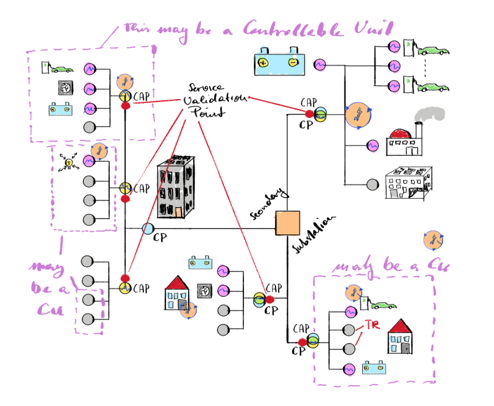Network Code on Demand Response Issue I - Definition of Controllable Unit
June 24, 2025
Throughout the recent months we have analysed carefully the ACER-reviewed version of the European Network Code on Demand Response ( [here] ). The document is a step forward, yet it contains a series of severe issues that need to be resolved. In a series of posts, we are highlighting some of these issues and make proposals for how to improve the final European legislative framework. We will begin with the definition of "Controllable Unit" or "CU" - the smallest active entity in the conceptual framework of the legal act.
System Operator Proposal
In order to understand the issue, it is important to review what ENTSO-E and EU DSO Entity had written in their proposal - firstly the definitions of 'controllable unit' and 'technical resource' in Article 2:
'Controllable unit' or 'CU', means a single technical resource or an ensemble of technical resources behind the same single accounting point, if these technical resources are commonly controlled.
‘Technical resource’ means an individual power generating module of type A, B, or C as defined according to Regulation (EU) 2016/631 connected to the distribution system, individual energy storage unit, demand units according to Commission Regulation (EU) 2016/1388 or any other consumption device.
The important reason for this is that both basic aggregation models - (i) dealing with the full customer site as a controllable unit and (ii) dealing with the more complex scenario of treating behind-the-meter assets are viable. (i) is used in many - if not even most - operational settings.

The picture above shows potentially registered 'controllable unit's colored in pink. Depending on the scenario, a charging station or battery may be registered and treated as a CU, but also a household as a whole may be treated as a CU. It is a very important conceptual basis for the set of rules defined in the Act to treat both options as viable.
ACER - proposed definition in Article 2
'controllable unit' or 'CU' means a single power-generating module and/or demand unit pursuant to Article 2 (5) of [RfG NC 2.0] and Article 2 (4) of [DC NC 2.0].
Please see the definitions of 'power-generating module' in the Requirements for Generators amendment proposal: ‘demand unit’ means an indivisible set of installations containing equipment which can be actively controlled by a demand facility owner or by a CDSO, either individually or commonly as part of demand aggregation through a third party to provide demand response services to relevant system operators and relevant TSOs or is a V1G electric vehicle and associated V1G electric vehicle supply equipment, power-to-gas demand unit or heatpump.
Please see the definitions of 'demand unit' in the Demand Connection Code amendment proposal: ‘demand unit’ means an indivisible set of installations containing equipment which can be actively controlled by a demand facility owner or by a CDSO, either individually or commonly as part of demand aggregation through a third party to provide demand response services to relevant system operators and relevant TSOs or is a V1G electric vehicle and associated V1G electric vehicle supply equipment, power-to-gas demand unit or heatpump.
The Issue
IMPORTANT: The change of definition of 'controllable unit'/'CU' actively invalidates Aggregation Model A - treating a customer installation as a whole as a 'CU'. Whilst to us the problem doesn't seem to be created intentionally, it is very important to get this corrected in the final legal text.
Recommendation
The final version of the code should revert back to the rationale of the systems operator proposal, allowing for technology and implementation neutrality, and restain from linking to single assets too much. Both basic aggregation models must remain viable.
